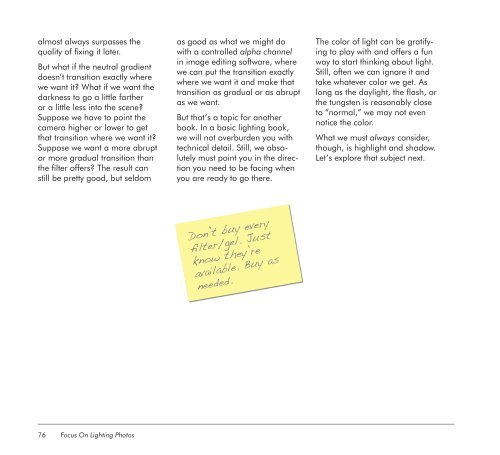Focus On Lighting Photos Focus on the Fundamentals.pdf
You also want an ePaper? Increase the reach of your titles
YUMPU automatically turns print PDFs into web optimized ePapers that Google loves.
almost always surpasses <strong>the</strong><br />
quality of fixing it later.<br />
But what if <strong>the</strong> neutral gradient<br />
doesn’t transiti<strong>on</strong> exactly where<br />
we want it? What if we want <strong>the</strong><br />
darkness to go a little far<strong>the</strong>r<br />
or a little less into <strong>the</strong> scene?<br />
Suppose we have to point <strong>the</strong><br />
camera higher or lower to get<br />
that transiti<strong>on</strong> where we want it?<br />
Suppose we want a more abrupt<br />
or more gradual transiti<strong>on</strong> than<br />
<strong>the</strong> filter offers? The result can<br />
still be pretty good, but seldom<br />
76<br />
<str<strong>on</strong>g>Focus</str<strong>on</strong>g> <str<strong>on</strong>g>On</str<strong>on</strong>g> <str<strong>on</strong>g>Lighting</str<strong>on</strong>g> <str<strong>on</strong>g>Photos</str<strong>on</strong>g><br />
as good as what we might do<br />
with a c<strong>on</strong>trolled alpha channel<br />
in image editing software, where<br />
we can put <strong>the</strong> transiti<strong>on</strong> exactly<br />
where we want it and make that<br />
transiti<strong>on</strong> as gradual or as abrupt<br />
as we want.<br />
But that’s a topic for ano<strong>the</strong>r<br />
book. In a basic lighting book,<br />
we will not overburden you with<br />
technical detail. Still, we absolutely<br />
must point you in <strong>the</strong> directi<strong>on</strong><br />
you need to be facing when<br />
you are ready to go <strong>the</strong>re.<br />
D<strong>on</strong>’t buy every<br />
filter/gel. Just<br />
know <strong>the</strong>y’re<br />
available. Buy as<br />
needed.<br />
The color of light can be gratifying<br />
to play with and offers a fun<br />
way to start thinking about light.<br />
Still, often we can ignore it and<br />
take whatever color we get. As<br />
l<strong>on</strong>g as <strong>the</strong> daylight, <strong>the</strong> flash, or<br />
<strong>the</strong> tungsten is reas<strong>on</strong>ably close<br />
to “normal,” we may not even<br />
notice <strong>the</strong> color.<br />
What we must always c<strong>on</strong>sider,<br />
though, is highlight and shadow.<br />
Let’s explore that subject next.



